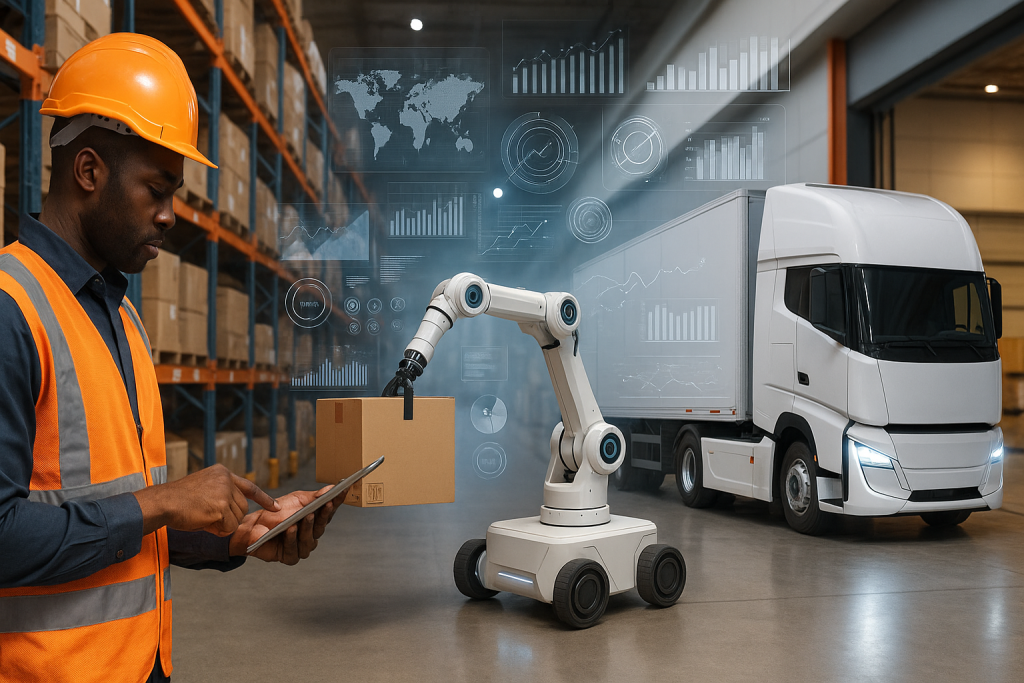By Martin Vassilev / 31 Oct, 2025
Canada’s logistics industry is undergoing a remarkable transformation. With technology advancing at an unprecedented pace and trade routes evolving due to global economic shifts, logistics providers are rethinking everything from warehouse automation to cross-border fulfillment. As we move through 2025, understanding the future of logistics in Canada is critical for businesses aiming to stay competitive in a rapidly changing landscape.
According to the Canadian Supply Chain Sector Council, logistics accounts for over 10% of the nation’s GDP. From AI-driven route optimization to sustainable green warehousing, the future promises smarter, faster, and more sustainable logistics solutions than ever before.
Artificial Intelligence and robotics are no longer futuristic ideas — they’re at the core of modern supply chains. AI is transforming predictive analytics, helping businesses forecast demand, reduce downtime, and improve inventory accuracy. Robotics, meanwhile, streamline repetitive warehouse tasks, reducing human error and enhancing operational speed.
Companies integrating these technologies are gaining a competitive edge. In a detailed breakdown on How AI Is Transforming the Logistics Industry in 2025, ByExpress highlights how automation not only minimizes costs but also enables real-time decision-making across the supply chain.
IoT sensors allow businesses to track every shipment in real-time — from departure to delivery. Smart devices relay data on location, temperature, and even handling conditions. For Canadian industries such as food distribution and pharmaceuticals, these innovations ensure compliance and enhance customer confidence.
Learn more about how real-time tracking drives transparency in logistics in ByExpress’ detailed article on Real-Time Tracking in Delivery Services.
Environmental responsibility is now a strategic business decision. Green logistics focuses on reducing carbon emissions, optimizing route planning, and using renewable energy in warehouses. Companies that embrace these practices not only meet government regulations but also attract environmentally conscious clients.
The Government of Canada’s Green Freight Program supports initiatives that improve energy efficiency in freight operations — a move that aligns with the logistics sector’s shift toward sustainability.
Electric vehicles (EVs) and hydrogen-powered trucks are transforming last-mile delivery. These solutions reduce emissions while maintaining efficiency. Major Canadian logistics hubs, from Vancouver to Montreal, are piloting clean energy transportation fleets to meet sustainability goals and federal emission standards.
With the increasing complexity of global trade, logistics companies are investing heavily in cross-border infrastructure. The strategic hubs between Calgary and Dallas are key examples of international collaboration that strengthen trade efficiency. Explore more in Calgary-Dallas Logistics Hubs: Connecting North American Trade.
Digitized customs clearance and blockchain-based document management are replacing outdated paper-based systems. These advancements simplify international shipping while enhancing transparency and reducing fraud.
For global exporters, initiatives by the Canada Border Services Agency (CBSA) streamline customs processes through automation, ensuring faster cross-border logistics for Canadian businesses.
On-demand warehousing allows businesses to scale storage capacity up or down depending on seasonal or market-driven changes. This flexibility is a game changer for Canadian e-commerce companies managing unpredictable inventory flows. Learn more about how ByExpress is leading this movement in On-Demand Warehousing Explained.
As online shopping surges across Canada, consumers now expect same-day or next-day delivery as standard. Fulfillment centers are adapting by leveraging advanced order-picking systems and robotic process automation to meet these expectations efficiently. The integration of real-time inventory management ensures seamless coordination between online stores and fulfillment warehouses.
ByExpress’ Ultimate Guide to Fast Fulfillment explains how automation is redefining customer satisfaction benchmarks in logistics.

The future of logistics is data-driven. Predictive analytics help companies anticipate bottlenecks, manage risk, and optimize delivery routes. Through data visualization and AI forecasting, logistics managers gain actionable insights that enhance performance and reduce operational costs.
In the Guide to Leveraging Data Analytics for Streamlined Inventory Management, ByExpress outlines how analytics enable companies to make more accurate, real-time decisions in logistics operations.
Blockchain technology is playing a key role in increasing transparency and security across the logistics chain. By providing an immutable record of every shipment, blockchain eliminates disputes, reduces paperwork, and ensures traceability from manufacturer to consumer. Learn how blockchain is redefining transparency in The Impact of Blockchain Technology on Logistics.
As Canada’s trade and technology landscape evolves, certain cities are emerging as logistics powerhouses. Ottawa’s central location, combined with access to major highways and ports, makes it a strategic logistics hub. Explore regional growth trends in Logistics in Ottawa.
Calgary and Vancouver, meanwhile, continue to expand their warehousing capacity to support both domestic and cross-border commerce. The shift toward distributed warehousing ensures that goods move faster, closer to the end customer, reducing transportation costs and delivery times.
Collaborative robots (cobots) and autonomous guided vehicles (AGVs) are revolutionizing warehouse operations. These machines handle inventory picking, sorting, and packaging with high precision. By reducing manual labor, they enhance both safety and efficiency.
The article The Future of Warehouse Automation provides a deep dive into how automation enables scalability without compromising quality.
Lean warehousing continues to gain traction as businesses seek to minimize waste and maximize efficiency. Implementing lean principles enhances operational flow and reduces unnecessary handling, ensuring faster throughput and cost savings. Learn more in Lean Warehousing: What It Is and How It Benefits Your Business.
The Canadian government’s National Trade Corridors Fund (NTCF) continues to invest in infrastructure that improves the efficiency and resilience of supply chains. These investments enable better connectivity between ports, airports, and railways, reinforcing Canada’s position as a leading trade hub in North America.
For official updates on logistics infrastructure projects, visit Transport Canada’s Trade Corridors Initiative.
As automation takes over repetitive tasks, the demand for skilled professionals in data management, robotics engineering, and supply chain analytics is rising. Canadian colleges and training programs are now integrating AI and logistics tech into their curricula to prepare the next generation for this digital revolution.
The future workforce must adapt quickly to technological advancements. Continuous learning and digital literacy are key for logistics professionals to stay relevant and productive in an increasingly automated environment.
The future of logistics in Canada is one of intelligence, agility, and sustainability. From AI-powered warehouses to eco-friendly freight networks, the logistics landscape is being reshaped to meet global standards. Companies that invest in technology, data, and green innovation today will lead the industry tomorrow.
ByExpress, one of Canada’s leading logistics and fulfillment providers, continues to pioneer future-ready solutions that help businesses adapt, scale, and thrive. For more insights or to transform your logistics strategy, contact ByExpress and stay ahead of 2025’s logistics evolution.
1. What are the biggest logistics trends in Canada for 2025?
Key trends include AI-driven automation, sustainable logistics, flexible fulfillment models, and blockchain transparency.
2. How is technology improving delivery times?
Automation, route optimization algorithms, and real-time tracking reduce human error and ensure faster delivery.
3. What role does sustainability play in Canadian logistics?
Sustainability initiatives reduce emissions and energy costs, enhancing brand image and compliance with national environmental goals.
4. How can businesses prepare for the logistics transformation?
By investing in AI tools, upgrading warehouse systems, and partnering with future-focused 3PL providers like ByExpress.
5. Which cities are becoming Canada’s logistics hotspots?
Ottawa, Vancouver, and Calgary are emerging as strategic logistics hubs due to their connectivity and infrastructure investments.

“Thanks to Byexpress all my shipping and fulfillment costs are in line now”

“All my issues were solved by Byexpress team that I had with pervious 3pl provider.”

“Thank you Byexpress team could not done it without you guys.”

“Their integration and customer service were the key for me”

“Outstanding delivery service! The package was well-packaged, and
the delivery team was professional and courteous”

“Great and knowledgeable team to work with.”

Thanks, guys, for reducing my shipping rates
Ottawa Office
2411 Holly Lane
Ottawa, ON, K1V 7P2
Toronto Office
13-280 West Beaver Creek Road Unit #136
Richmond Hill, ON, L4B 3Z1
Alexandria Office
173 Kenyon Street West
Alexandria, ON, K0C 1A0
Montreal Office
4388 Saint-Denis Street Unit #200
Montreal, QC, H2J 2L1
California Office
155 North Riverview Drive
Anaheim Hills, CA, 92808
Call Us
Toll-Free: 1-866-744-7122
Local : 613-739-3000
Email Us
Multilingual Services










